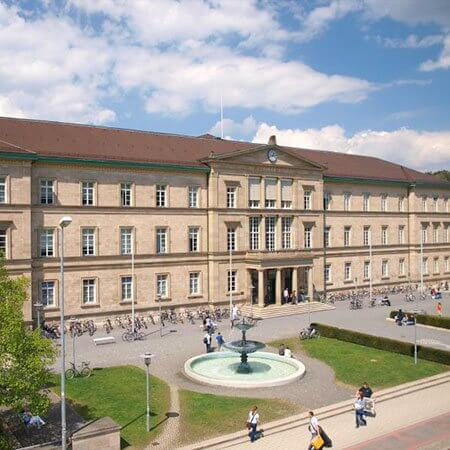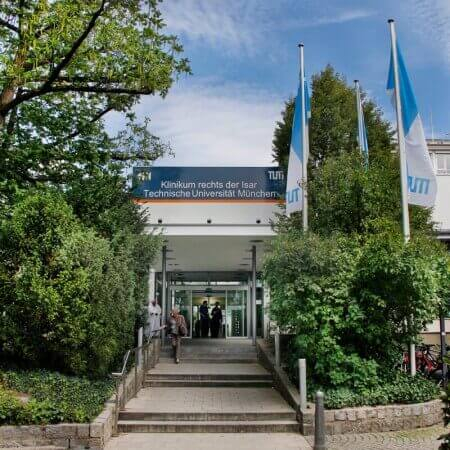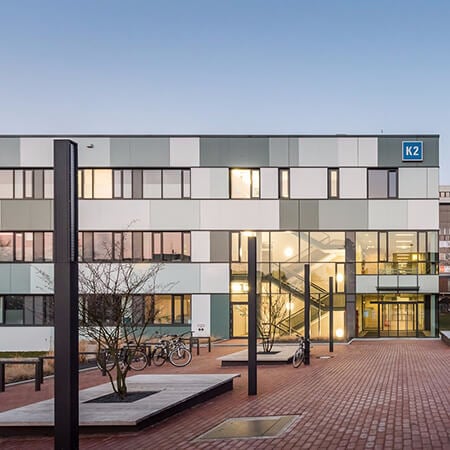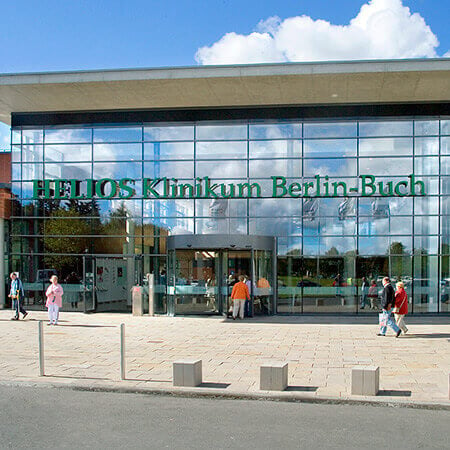Uterine myoma
Uterine myoma is a benign tumour arising from the smooth muscle cells of the corresponding organ. Myoma remains among the most common gynaecological pathologies and reaches 25% in the structure of all the female diseases. According to the autopsy data, myomas of different size are identified in 80% of women. Meanwhile, clinical signs are present just in 35% of patients suffering from this disease.
The Booking Health portal presents 72 German clinics specializing in uterine myoma treatment
Show all clinicsUterine myoma – Diagnostics
Ultrasound is the main method for diagnosing uterine myoma. It can not only detect myomatous nodes, but also determine their characteristics:
- Size
- Structure
- Location
- Number
- Type of growth
Except for the ultrasound of the pelvic organs there are also improved and more informative diagnostics measures with the use of ultrasound. The following techniques are among them:
- Hydrosonography means that ultrasound diagnosis is performed after injecting a saline solution into the uterus. The contrast of all intrauterine structures significantly improves in the liquid medium. Hydrosonography allows the doctor to establish the correct diagnosis with almost 100% probability
- Dopplerography is an ultrasound with a Doppler sensor used to measure the speed of blood flow in the vessels, assess the condition of veins and arteries. Dopplerography is used in planning the treatment of uterine myoma by uterine artery embolization, as well as to evaluate the effectiveness of the operation.
- Angiography is an X-ray method of diagnostics with contrasting agent injection into the blood vessels. It is used before the embolization of uterine arteries.
- Hysteroscopy is an endoscopic examination, when a special instrument called a hysteroscope is introduced into the uterus. The diagnostic method can immediately become curative if the doctor performs removal of the myomatous nodes.
- Laparoscopy is a diagnostic operation performed in case of subserous nodes, or if the tumours are located in the retroperitoneal space.
Best clinics for the uterine myoma diagnostics in Germany:
Uterine myoma – Treatment
Therapeutic tactic is determined by a number of factors. The main ones are:
- Size, structure, and localization of the malformation
- Presence or absence of symptoms, their severity
- Age of the woman and her desire to maintain (restore) the reproductive function
If a woman does not plan to have children in the future, then conservative therapy is applied to stop bleeding and avoid anemia. Conservative treatment is used if nodules size is under 3 cm. If myoma is larger than that, then surgery is indicated even if a woman doesn’t plan childbirth.
Surgical treatment techniques are:
Hysterectomy is the removal of the uterus which is the most effective method of treating fibroids. This does not affect the quality of sexual life. There may be a deficiency of estrogen after surgery, but it is compensated with the help of hormonal drugs. This method of treatment is unacceptable for women, who want to maintain fertility.
Indications for the uterus removal in the case of myoma:
- Size of uterus is more than at a 15-week-pregnancy
- Uterus growth more than 4-week-pregnancy per year
- Suspicion of the malignant oncological process
- Cervical uterine myoma
- Dysfunction of neighbouring organs (bladder, kidney, intestine)
- Violation of trophism (nutrition, blood supply) of the myomatous node
- Persistent bleeding when it is impossible to perform organ-saving operations
Surgery can be performed through the laparotomic (by open access) or laparoscopic (introduction of the optical system and surgical instruments through the small incisions) access.
Specialists in German hospitals prefer laparoscopic procedures. They require special skills and the advanced equipment, but have a lot of advantages:
- Lower risk of complications
- Shorter rehabilitation period
- Better aesthetic effect
Laparoscopy cannot be performed if the uterus has a large size (more than 17-week-pregnancy), the location of the myomatous node is on the back wall of the uterus, and if there are some accompanying gynaecological diseases.
Transcervical myomectomy is the main organ-saving operation, which is performed in most European hospitals. Its possibility depends on the shape of the myomatous node, its size and location. The tumour is removed with a hysteroresectoscope or laparoscope. Doctors use mechanical, electrical or laser methods to remove the malformation. Transcervical myomectomy is indicated if a nodule size is 5-10 cm. If nodules are larger, preliminary treatment with hormonal preparations is possible. It helps to reduce the size of the formation by 30-35%.
Embolization of the uterine arteries is an effective non-surgical technique for the treatment of uterine fibroids, which is successfully performed in German and European hospitals. It leads to a decrease or disappearance of symptoms. After uterine arteries are blocked, the myomatous nodes shrink. The size of the uterus decreases by 2.5 times one year after the procedure, and the tumour decreases significantly.
Laparoscopic occlusion of uterine arteries is minimally invasive method of treatment, involving the ligation of uterine arteries. It is less effective than embolization, but it is safer and better tolerated by patients.
Uterine myoma – Innovative treatment
Nowadays, there are many effective techniques of radical or symptomatic uterine myoma treatment. New therapeutic approaches are being developed regularly, directed at the reduction of tissue trauma while removing the tumour.
Radiofrequency ablation is a high-tech, minimally invasive method for treating uterine myoma, which does not require surgical intervention. A needle device is inserted into the myomatous node through the abdominal wall. Myoma is warmed up to a high temperature and then its destruction occurs.
Distant thermocoagulation of nodes is an innovative method of treatment, which is used in several German hospitals for the treatment of uterine myoma. The procedure is performed under the visual control of a magnetic resonance imaging. The focused energy of ultrasonic waves is used to heat the nodes, which results is necrosis (ruining) and rejection of the tumour.
Benefits of such a treatment technique are:
- Absence of surgery, therefore, there is no long recovery period
- Minimal risk of complications
- Procedure is outpatient and takes only 1 to 3 hours
The effectiveness of distant thermocoagulation of myomatous nodules is about 75%. The need for another procedure occurs in 20% of women. At the moment there are ongoing studies aimed at obtaining more accurate information about the effectiveness of using focused high-frequency ultrasound in uterine myoma treatment.
Best clinics for the uterine myoma treatment in Germany:

University Hospital Tuebingen
8023.28

University Hospital Rechts der Isar Munich

Hannover Medical School (MHH)
Uterine myoma – Rehabilitation
Rehabilitation is the process of body restoration from injuries, surgeries or diseases. It can have a different orientation such as: oncological, orthopedic, neurological, etc. There is also general therapeutic rehabilitation. It is indicated for patients after conservative and surgical treatment of the internal organs diseases.
The directions of the general therapeutic rehabilitation
There are several main directions of the therapeutic rehabilitation such as:
- Medical one, which includes the restoration of patient's health, normalization of body functions, stimulation of compensatory possibilities, elimination of the chronic pain, etc.
- Physical one, which is responsible for improving of work capacity and tolerance for physical activities. In the complex cases, the purpose of this therapeutic rehabilitation area may be the restoration of the self-service ability.
- Psychological one, which helps to eliminate the mental disorders which may occur as a result of a disease (phobias, depression, apathy), to increase the human motivation, and to adapt to the changed living conditions.
The World Health Organization underlines 3 phases of rehabilitation such as: hospital phase, a phase of recovery and supporting phase. Different tasks are solved in different phases. The hospital phase is conducted immediately after the treatment. After the first phase begins the second one which usually takes place in sanatoriums or rehabilitation centers. This is the boundary between two periods, namely illness and future life. Then a supporting phase is required. The patient maintains the achieved level of his health and physical activity at home or visits the rehabilitation center from time to time.
Therapeutic rehabilitation methods
The most modern rehabilitation programs are used in Germany. They are adapted individually for each patient, and are based on the recent disease, age, physical possibilities, and the results of treatment. Different specialists such as: therapists, psychologists, rehabilitators, kinesiotherapists, physiotherapists are involved in the rehabilitation process.
The following methods of rehabilitation are used:
- Dosed physical activity
- Training on the simulators and in the pool
- Physiotherapy
- Acupuncture
- Manual therapy
- Microcurrent therapy
- Compression therapy
- Lymphatic drainage
- Natural factors of the nature (mud, thermal waters, etc.)
Any rehabilitation may include medicamentous support. It is necessary to hold a consultation with the patient about the proper nutrition and the way of life which is important for him in the current situation.
Rehabilitation programs in Germany are designed for 2 weeks. If necessary, they can last much longer. In this country, the patient is provided with qualitative care, accommodation in comfortable rooms and individually selected meals.
Rehabilitation programs in Germany show one of the best results in the world. Most patients successfully restore their employability and excellent health there. They remain physically active, return to the full social and family life.
Best clinics for general therapeutic rehabilitation in Germany:
Author:
The article was edited by medical expert, board certified Dr. Nadezhda Ivanisova. For the treatment of the conditions referred to in the article you must consult a doctor; the information in the article is not intended for self-medication!
Source:
Centers for Disease Control and Prevention
The cost of services includes
Here you can find the cost of treatment for this disease at the German University Hospitals. Leave a request and we will provide a free consultation with a doctor and will start organizing the whole treatment process.
The program includes the following:
- Issuing of an invitation for getting a visa for treatment as quick as possible
- Fixing an appointment at a time convenient for you
- Preliminary organization of a comprehensive examination and discussion of the forthcoming treatment plan
- Arranging transfer from the airport to the hospital and back to the airport
- Provision of interpreting services and services of a personal medical coordinator
- If necessary, assistance in the organization of further surgical treatment
- Provision of a medical insurance against treatment complications covering up to 200,000 euro
- Preparation and translation of medical records and recommendations from the hospital
- Assistance in the subsequent communication with your attending physician, including consultations on repeated X-ray images through the unique medical document management system E-doc



